Stylebook editor Paula Froke spoke at the ACES: The Society for Editing conference earlier this year, and announced numerous new entries and updates to the Associated Press Stylebook. These include several updates to gender and sexual orientation. Here’s a recap that includes a few of the rules for terminology used during Pride Month:
• LGBTQ+ (revised to add the + sign)
Acceptable in all references for lesbian, gay, bisexual, transgender, and queer and/or questioning, plus other sexual and gender minorities. Fewer or additional letters can be used to be more inclusive or in quotations and names of organizations and events, such as LGBT or LGBTQIA. I stands for intersex, and A typically stands for asexual (a person who doesn’t experience sexual attraction).
• transgender (adj.) (expands on previous guidance)
Describes people whose gender does not match the one usually associated with the sex they were assigned at birth. Identify people as transgender only when relevant, and use the name by which they live publicly.
Avoid references to a transgender person being born a boy or girl, or phrasing like birth gender. Sex (or gender) assigned at birth is the accurate terminology. The shorthand trans is acceptable on second reference and in headlines.
A person who is assigned female at birth and transitions to align with their identity as a boy or man is a transgender boy or transgender man, and a person who is assigned male at birth and transitions to align with their identity as a girl or woman is a transgender girl or woman.
• deadnaming (expands on previous guidance)
The practice, widely considered insensitive, offensive or damaging, of referring to transgender people who have changed their name by the name they used before their transition. Use a person’s previous name or pre-transition image only if required to understand the news or if requested by the person.
The issue of deadnaming often arises when public figures announce a gender transition. In these and other cases, generally use the deadname only once and not in the opening paragraph, with future coverage using only the new name.
• queer (new)
Many LGBTQ+ people now use the word queer as a point of empowerment to refer to a sexual orientation or gender identity.
The term sometimes is used as a synonym for LGBTQ+. However, because of its origins as a slur, queer is not universally accepted among LGBTQ+ people, and its use tends to be more prevalent among younger generations.
In a PRSA Webinar on June 22, Paula Froke, editor of The Associated Press Stylebook, will discuss why inclusion matters in writing and editing. Froke will walk participants through some of the principles of the AP Stylebook’s major inclusion chapters and entries. Learn more about inclusion in reporting, writing and editing at this link.
[Photo credit: windy night]







